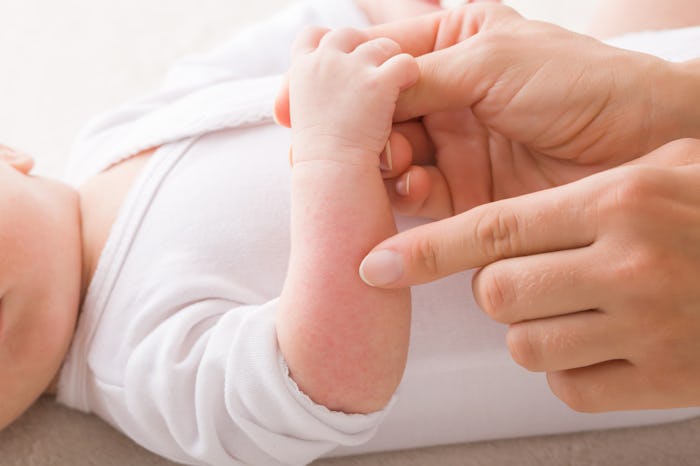Rashes

Does Your Baby Have Bumpy Patches On Their Arms & Legs? It Might Be KP
Rashes on babies make us panic, but keratosis pilaris is NBD.
There is no shortage of rashes your baby can develop when they’re little, and the moment you notice any bumps or redness, it’s natural to worry (and start Googling it feverishly — wait, do they have a fever). If your little one has sprouted some bumpy patches on their arm and legs, you could be dealing with keratosis pilaris. Fortunately, keratosis pilaris in babies is really nothing to worry about.
Keratosis pilaris (KP) causes rough, bumpy patches you can see and feel on the skin. Sometimes the bumps are accompanied by redness. It tends to appear on the upper arms, thighs, buttocks, and cheeks. So what causes it to pop up in the first place?
“I would consider keratosis pilaris to be a dry skin type more so than a dry skin problem. It’s extremely common,” says Dr. Catherine Bridges, M.D., pediatric dermatologist at Cincinnati Children’s and assistant professor of dermatology and pediatrics at the University of Cincinnati. “Essentially what happens is that where all of the little hair follicles come out, there’s just a little bit of extra top layer of the skin that doesn’t like to fall off. So that’s what leads to the little rough bumps that people can sometimes see and feel.”
Keratosis pilaris in babies
KP can appear on your baby’s skin anytime after birth, really, but tends to become more obvious as they get a bit bigger, Bridges says (which makes sense, since they need to be growing body hair for it to form). If you’ve just spotted the telltale bumps and redness on your baby’s arms for the first time, fear not: it shouldn’t bother them at all.
“It is something that’s typically just kind of there. It is typically not symptomatic,” says Bridges. Sometimes it may get a little itchy, she adds, but for the vast majority of people, it doesn’t even do that. You might notice your baby’s KP gets worse at times — because it’s essentially a dry skin type, per Bridges, anything that dries out your skin could make more bumps pop up for baby.
“Conditions that would worsen dry skin can make it more noticeable. So of course during the wintertime when we’re running our heaters it’s very dry inside the home. That can make it more noticeable. Some people really scrub up with soap and soap can be drying to the skin, so that can make it a little bit more noticeable as well.”
Because food allergies are a common concern for parents as their babies begin trying new foods, and skin rashes can be associated with allergic reactions, you might be wondering if there are any dietary changes you can make to help reduce your baby’s KP breakouts. There’s no link between your baby or toddler’s diet and KP. “There’s no association with food,” Bridges says. “Most parents are really worried, ‘is there something that I’m doing or not doing to cause this?’ And that’s not the case. It’s just kind of how their skin likes to be.”
Can you get rid of keratosis pilaris?
In short, no. Because it’s just how your baby’s skin forms, there’s not really any changing it. “You don’t have to treat it. This is something that is going to stick with people. There are a few ways to make it less noticeable, but kind of just knowing that there’s nothing that’s going to make it go away completely forever is something that I think is really helpful for parents,” Bridges says.
How can you make it better? Most kids (and adults) with KP benefit from moisturizing daily, and Bridges says your baby’s lotion will be most effective if you apply it right after a bath. Look for gentle, fragrance-free formulas with thicker textures, she says, noting that coconut oil is a good option for parents who want to use something all-natural. You can also skip the soap where it’s not needed during your baby’s baths.
“You don’t need to lather up the skin with soap every single time,” Bridges says. “Of course, if they’ve rolled in a mud pit, that’s something different. But in general, the only places where you need to use a nice gentle soap are the body folds — the neck, the groin, the underarms. Everything else, for the most part, you can rinse with water.”
Keratosis pilaris occurs more commonly in kids who have eczema, and those who have eczema are more likely to also have KP, Bridges says. So, if you’re looking into the best moisturizer for KP or wanting to reduce its appearance, you should definitely check with a doctor before trying anything at home.
“If families are concerned enough to be wanting to pursue a specific treatment to make it less noticeable, I think the first step is really to meet with your pediatrician or a pediatric dermatologist to ensure that we actually know what’s going on, and then that provider can give the family recommendation of what is really the best moisturizer for the skin condition or the type of skin the patient has, and for the age of the patient,” says Bridges.
Long story short, if your baby has KP, they’ll probably have it for life (though it will get less noticeable with age). That said, it doesn’t hurt and should only itch on occasion, if ever, so don’t worry too much about it. You have enough to think about as it is.
Expert:
Dr. Catherine Bridges, M.D., pediatric dermatologist at Cincinnati Children’s and assistant professor of dermatology and pediatrics at the University of Cincinnati
This article was originally published on